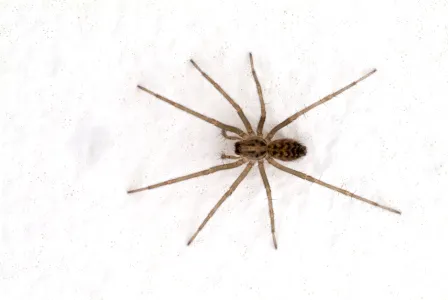About Spiders
Spiders are fascinating and diverse creatures that play an important role in controlling insects around your home and yard. With thousands of species worldwide, they come in many shapes, sizes, and colors, but most are harmless to humans. While some spiders spin the classic webs you might find in corners or gardens, others are active hunters that roam in search of prey. Learning more about these common arachnids can help you identify them, understand their behavior, and know when they might become a concern.
What Do Spiders Look Like?
Spiders are arachnids, which means they have eight legs and two main body segments: the cephalothorax (front) and the abdomen (back). They vary widely in size, shape, and color depending on the species, but there are some common features to help you identify them.

Key features of spiders include:
- Eight legs: All spiders have eight jointed legs, unlike insects, which have six.
- Two body segments: A cephalothorax and an abdomen.
- Varied sizes: Ranging from tiny pinheads to several inches across, depending on the species.
- Color and markings: Colors range from brown, black, or gray to more vibrant patterns in some species.
- Silk-producing spinnerets: Located at the rear of the abdomen, used to spin webs or wrap prey.
What Are The Unique Characteristics of Spiders?
Spiders are fascinating arachnids known for their silk-spinning abilities, venomous fangs, and important role as natural pest controllers. While many spin webs to catch prey, others hunt actively, showing incredible adaptability and survival skills.
Some other interesting characteristics of spiders include:
- Ability to regenerate legs after molting in some species.
- Specialized hairs on legs that detect vibrations and airflow.
- Egg sacs that protect offspring until they hatch.
- Diverse sizes and shapes, from tiny jumping spiders to large orb-weavers.
- Use of silk beyond webs, including draglines, shelters, and parachuting for dispersal.
What Do Spiders Eat?
Spiders are carnivorous and primarily feed on insects and other small arthropods. Their diet can include flies, mosquitoes, ants, beetles, and even other spiders. Web-building spiders often catch prey that gets trapped in their sticky silk, while hunting spiders actively stalk or ambush their meals. By feeding on insects, spiders play an important role in keeping pest populations under control in gardens, yards, and even inside homes.
Where Are Spiders Commonly Found?
Spiders can be found almost anywhere, but they prefer locations that offer shelter and a steady supply of insects. Many are drawn to corners, basements, attics, and crawl spaces inside homes, while others thrive outdoors in gardens, woodpiles, shrubs, and under rocks or debris. Web-building species often stay in areas where flying insects are abundant, whereas hunting spiders roam open spaces in search of prey.
What Are The Risks of Having a Spider Infestation?
A spider infestation can be unsettling and, in some cases, problematic. While most spiders are harmless, large numbers can create unsightly webs around the home, making spaces feel cluttered and unkempt. Some species have venomous bites that can pose a health risk, especially to children, pets, or those with allergies. Additionally, an abundance of spiders may indicate a high insect population, meaning other pests could also be present in your home or yard.
If you're in the Boise area, you can count on Affinity Pest Control for professional spider removal services that are fast, effective, and tailored to your home’s needs.